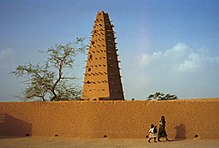Historic center of Agadez
| Historic center of Agadez | |
|---|---|
|
UNESCO world heritage |
|

|
|
| View from the minaret of the Great Mosque to Agadez |
|
| National territory: |
|
| Type: | Culture |
| Criteria : | (ii) (iii) |
| Surface: | 77.6 ha |
| Buffer zone: | 98.1 ha |
| Reference No .: | 1268 |
| UNESCO region : | Africa |
| History of enrollment | |
| Enrollment: | 2013 (session 37) |
The historic center of Agadez is a UNESCO World Heritage Site . Its core zone includes the historic city center of the city of Agadez in Niger , which dates back to the 15th and 16th centuries. The houses, palaces and mosques in the historic center are characterized by traditional adobe architecture. Around 20,000 people live in the city center.
Area
The UNESCO World Heritage Site consists of a 77.6 hectare core zone - the actual old town - and a 98.1 hectare buffer zone that completely surrounds the core zone. The historic center is traditionally divided into eleven districts with irregular surfaces. These are Agar Garin Saka , Akanfaya , Amarewat , Amdit , Angoual Bayi , Founé Imé , Hougbéry , Katanga , Obitara , Oumourdan Magass and Oumourdan Nafala .
The old town of Agadez in its current form dates back to the 15th and 16th centuries, when the Sultanate of Aïr , which still exists today, established itself here. It has about 20,000 inhabitants who carry on the local traditions of culture, trade and handicrafts. Architecturally, the historic center is characterized by adobe buildings and a decorative style typical of the Aïr region. In addition to many residential buildings of this type, there are well-preserved mosques and palaces.
Outstanding buildings and places
One of the most famous buildings in the world heritage site is the Great Mosque of Agadez with its iconic 27 meter high minaret . Other important mosques are the Abawagé Mosque, the Hassana Mosque and the Tendé Mosque.
Larger palaces are the Sultan's Palace of Agadez , the Palace of Anastafidet and the residence of the Sultan Almoumine. The outstanding buildings also include the Ati Sarkin Fawa House, the Mahadi House, the House of Qādī and the Sidi Kâ House, as well as the Hotel de l'Aïr and the Le Pilier restaurant.
Significant squares are Kofar Sarki Square, Night Market Square, Sherif Square , Tamallakoye Square and Toundoun Gabass Square.
History as a world heritage site
The historic center of Agadez was put on the tentative list in 2006 and was recognized as a UNESCO World Heritage Site on June 23, 2013. It is the third World Heritage Site in Niger after the Aïr and Ténéré nature reserve recognized in 1991 and the W National Park recognized in 1996 , where the world heritage status was extended to the W-Arly-Pendjari National Park complex in 2017 .
literature
- Aboubacar Adamou: Agadez et sa Région (= Études Nigériennes . No. 44 ). Pr. De Copédith, Paris 1979.
- Marko Scholze: Arrested heritage. The politics of inscription into the UNESCO World Heritage list: the case of Agadez in Niger . In: Journal of Material Culture . Vol. 13, No. 2 , 2008, p. 215-231 .
Web links
Individual evidence
- ↑ a b Historic Center of Agadez. UNESCO World Heritage Center, accessed February 5, 2018 .
- ↑ a b Agadez. Plan de Gestion du center historique, 2012–2018. (PDF) Ministère de la Jeunesse, des Sports et de la Culture, January 2012, p. 18 , accessed on February 5, 2018 (French).
- ^ Historic Center of Agadez (Niger). No 1268. (PDF) ICOMOS, p. 63 , accessed on February 5, 2018 (English).
- ↑ Niger. UNESCO World Heritage Center, accessed February 5, 2018 .
Coordinates: 16 ° 58 ′ 27.8 ″ N , 7 ° 59 ′ 22.6 ″ E


